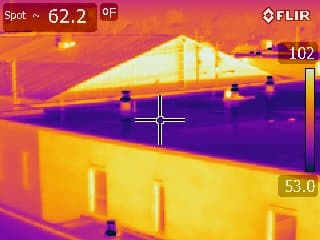The building envelope is the most important system in a structure. It is the boundary between a building’s interior and the exterior environment and provides a weathertight barrier. Regularly assessing the performance of your building envelope is an important part of preventative maintenance and can help identify issues before they can become a life-safety concern or too cost-intensive to repair, thus reducing your overall total cost of ownership. Two of the most common culprits affecting the performance of your building envelope are water intrusion and air leakage, but what is the best and most cost-effective way to find out if these issues are affecting the integrity of your structure?
A Non-Invasive Method for Thermographic Scanning
Thermography is a non-invasive methodology for measuring the surface temperature of a structure using infrared cameras and/or video. A thermographic scan can be performed either as an interior or exterior survey. With thermal imaging, variations in temperature are reflected via a spectrum of colors ranging from lighter colors for warm areas to darker colors for cold areas.
The variations in temperature from an infrared scan can indicate whether air is entering or exiting the building and can help determine if more insulation is needed to improve energy efficiency and to increase occupant comfort. Additionally, use of thermographic scans can detect roof leaks because wet insulation conducts heat faster than dry installation. Scans can also be used to detect thermal bridging which acts as an energy shortcut, allowing heat to move across an object with better conductivity than the materials around it (i.e. wall studs or metal fasteners transfer heat more quickly than insulation). Thermal bridging creates energy loss that can compromise a building’s energy efficiency. Thermal imaging scans can also be used to determine if mechanical systems are overheating or potentially installed incorrectly, preventing potential life safety issues or worse, litigation.
Using Drones for Hard-to-Reach Places
Not all areas of the building envelope are always easy to reach due to slope, height or other accessibility and safety issues. This is when a small, unmanned aircraft system (sUAS), such as a drone, can be used for a thermographic scan. Use of a drone can help a thermographic assessor take scans of dangerous or fragile areas, providing a safer, more cost effective and accessible methodology. Since most thermal scans are conducted at night, drones can help mitigate access and safety issues and allow for scans to be performed during a wider range of environmental conditions. Drones provide both a safe and time-effective way to collect the data for a complete infrared survey.
When to Use Thermal Imaging
Many new construction projects now require thermal imaging to be performed on the roofing and exterior wall assemblies as part of Building Enclosure Commissioning (BECx) prior to project closeout. Thermal imaging surveys can also be retro-commissioned for older buildings to improve energy efficiency and resolve issues such as air or water leaks that cannot be seen with the naked eye. Industry standardized tests such as ASTM E1186, ASTM E779 and ASTM C1153 can provide a detailed analysis of air leakage and water infiltration into a building’s structure and can be performed alone or as part of more comprehensive performance testing.
With 30 years of building envelope and structural engineering consultation experience, Technical Assurance offers you a comprehensive approach to preserving the life of your most expensive assets. Our commissioning and retro-commissioning services can help you identify problem areas and improve the overall efficiency of your building. We are proud to be your partner in quality assurance.
Contact Us Today!
Technical Assurance can help you take a proactive approach to ensure optimal performance of your building envelope. Contact us today for a consultation and assure that your investment lasts well into the future.
Sources:
How Thermographic Inspections Work, US Department of Energy https://www.energy.gov/energysaver/thermographic-inspections

